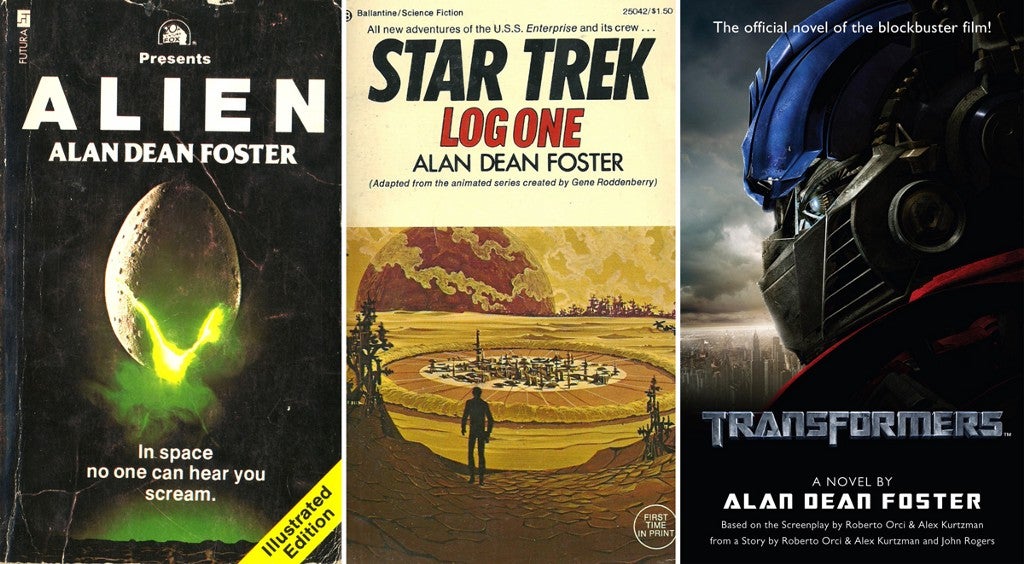“I haunted bookstores and would see novelizations,” Alan Dean Foster recalls, sitting in the study of his Prescott, Arizona, home. “I thought, Well, that’s interesting — I didn’t know there was a book version of that movie. I was writing original novels and original short fiction.”
This was before Foster would become one of the most famous authors in the world of science-fiction novelizations — back in the early 1970s, when he was still living in Los Angeles and starting to make his name as a writer. It was a career that almost didn’t happen. Foster had majored in political science at UCLA, a path to law school all but assured. It’s now July 2015 as he talks to me, still able to remember the pivot his life took. “I never thought of being a writer, you know? They give you all these aptitude tests in junior high and high school — supposedly to guide your direction for the rest of your life — and all of mine kept coming up, ‘Lawyer, lawyer, lawyer.’ There were lawyers in the family, so I thought, All right, I’ll be a lawyer.”
He had already been accepted into law school at USC and Loyola Marymount, but for the hell of it, he applied to UCLA’s graduate film program. He got in. During his MFA program, he wrote his first novel, The Tar-Aiym Krang, sold it, and has kept on writing.
“Your life hinges on very small things, very small events, very small decisions,” says Foster, who has published more than 100 books, which doesn’t even include all the short stories and nonfiction pieces he’s written. “If I had not gotten into UCLA film school, I probably would’ve gone to law school, and I probably would have made more money, but be considerably less happy.”
Foster’s study is where he spends a good portion of every day. Here he writes short stories; a column for the local newspaper; a lot of sci-fi, sometimes for his ongoing series, including the Humanx Commonwealth and Spellsinger series. But recently, he finished one of his most high-profile works: the novelization of the much-anticipated film Star Wars: The Force Awakens.

It’s not like he’s new to the world of Luke Skywalker and Han Solo — he’s been there from the start. When George Lucas was preparing the novelization for the first movie in the franchise back in the mid-1970s, he met with Foster. Lucas was aware of Foster’s 1974 novel Icerigger, about two mismatched men forced to survive on a dangerous frozen planet, and Foster was offered the job. There was one condition, though: Lucas’ name would be on the cover of the novelization, not Foster’s.
“I had no trouble with that,” Foster insists. “It was his story, not mine, but I couldn’t admit to having done the job. And so for many years, I had to look very close acquaintances in the face and lie. There were one or two friends who said, ‘Well, this passage here really reads like your writing.’ And I still had to lie to them.”
Novelizations — ancillary tie-ins to event movies — have been part of the industry for generations. (Even the original King Kong, from 1933, had a novelization, written by Delos W. Lovelace.) Foster had done novelizations before Star Wars — his first was for a ghastly Italian movie, a female Tarzan drama — but soon it became a sidelight of his career. He wrote the novelizations for The Black Hole, Clash of the Titans, John Carpenter’s version of The Thing. Adapting Alien for the page proved incredibly difficult when the executives at 20th Century Fox refused to show him a single image of the alien, fearing security breaches.
“If you read the book version of Alien, there’s no description of the alien,” Foster says. It’s not so difficult now, even with a closely-guarded film like Star Wars: The Force Awakens. “There are now online security systems which probably put those of the NSA to shame,” he adds. “It is possible through these systems to send me things like production stills, pre-production artwork and the screenplay in a fashion that ensures that nobody else is gonna get a hold of them.”
He received the first email about the possibility of writing the book of The Force Awakens on January 28, 2015, and started work on the manuscript on March 23. He was done in less than two months. “It needs a final approval from the studio — whoever controls the rights always has final approval,” Foster explains. “But unless there’s some violent objections from people involved with the film, it’s a done deal.”
This is the reality of writers who do novelizations: You work fast, and you work under pressure. “When I’m asked to do a novelization, the publisher generally wants it yesterday,” says Foster. It’s a point of pride for him to work quickly. “If I’m given eight weeks, I wanna make sure it’s done in six weeks. And if I’m given six weeks, I wanna make sure it’s done in four weeks.”
If Foster sounds a bit like a craftsman as opposed to an artiste, that’s part of the gig for a novelization author. Twice during our conversation, he compares himself to a house painter, doing a job to someone else’s specifications. There’s no discontent in his voice — and more than a dash of enthusiasm.
“When I’m doing novelizations, I’m a combination of professional writer and 14-year-old kid sitting in the back of the theater with his friends loudly criticizing the bad special effects,” he says. “When they announced the seventh [Star Wars] film, your brain immediately starts percolating: I’d like to see this. I wonder how they’re gonna handle that. What are they gonna do with so-and-so?”
Ask him what his conversations were like with Force Awakens director J.J. Abrams during the novelization process, and Foster just laughs. “I’ve never met J.J.,” he replies. This is even more amazing considering that Foster wrote the novelizations for both recent Star Trek reboots that Abrams also directed. “Hopefully that’ll be rectified one of these days,” Foster adds. “But I know what the filmmaking process is like, and the last thing a director has time to do is sit down with anybody who’s working on anything that’s just an ancillary product. I respect the original material, and hopefully the final product is something that — if the director even reads it or the producer even reads it — they’ll be happy with it as well. But it’s a spinoff product. Basically, I’m off doing my own thing.”
There have been times, however, where he hasn’t respected the original material. It’s best not to bring up Alien 3. When he asks me if I’ve seen the movie, I admit that I have, and wasn’t too fond of it. “Nobody liked it very much,” he snorts. “Don’t feel exclusive.” Ideally, the novelization author is following the script, adding color and texture but not radically rewriting the narrative. But Foster felt he had to do so in this case. “I think I fixed a lot of things in Alien 3 in the book version, and the producers said, ‘You can’t do that.’”
He goes into his war story, the tale of the novelization that went awry. “Alien 3 takes place on a prison planet, and you got all these guys who are locked up there. And in the course of writing the original manuscript, I created backgrounds for these guys so that they wouldn’t just be ciphers or alien chow. I had to take all that out.”

He also hated that Ripley’s character requests an autopsy on Newt, the girl she safeguarded in Aliens, which he also wrote the novelization on. “I have said many times over the years that [the autopsy scene] was an obscenity,” says Foster, passion rising in his voice. “Not only that, it removes Ripley’s motivation for staying alive, which is to protect the little girl. You kill the little girl, Ripley has no motivation for staying alive. So I devised a method whereby the little girl wasn’t dead.” The producers blocked that change as well, which became a dealbreaker for Foster — who begrudgingly relented. When they later offered him the chance to novelize Alien: Resurrection, he said no.
There have been other instances where the work didn’t go smoothly. He decided on his own to rewrite Terminator Salvation because the completed film (due to extensive reshoots that happened after he turned in his draft) ended up so different than his novelization. This can be thankless work, telling the story of a movie in a different format, following the blueprint laid out by other people. How does Foster make peace with being the house painter in this creative process? “I take the money and I spend it on something nice,” he tells me.
Foster likes Prescott, likes the quiet it affords him to write. He never fully enjoyed the noise and bustle of Los Angeles. Even now when he writes, he’ll sometimes pull out his big, heavy, old-fashioned plastic earmuffs, the ones worn by airport ground crews who lead the planes to their terminal. “Sometimes the sound of my own heart will get in there and disturb me,” Foster says, “but I have to shut that out, ’cause I have no way to turn that off.”
With The Force Awakens long over, he’s already thick into other work. He’s writing two short stories, and he’s working on his monthly column for the paper. “Doing short stories is relaxation,” he says. The writing consumes him, and hearing him talking about the intensity of his focus on the material, it can sound overwhelming.
Does he actually enjoy his work?
“I enjoy it two times,” he says. “I enjoy it when I hit a passage where I haven’t really thought out what I’m gonna do, and what appears on the computer screen really works. The other enjoyable thing is when I type ‘The End.’”
Tim Grierson is one-half of The New Republic’s film column Grierson and Leitch. He is also a frequent contributor to Rolling Stone and Vulture as well as the author of six books, including Martin Scorsese in Ten Scenes.

